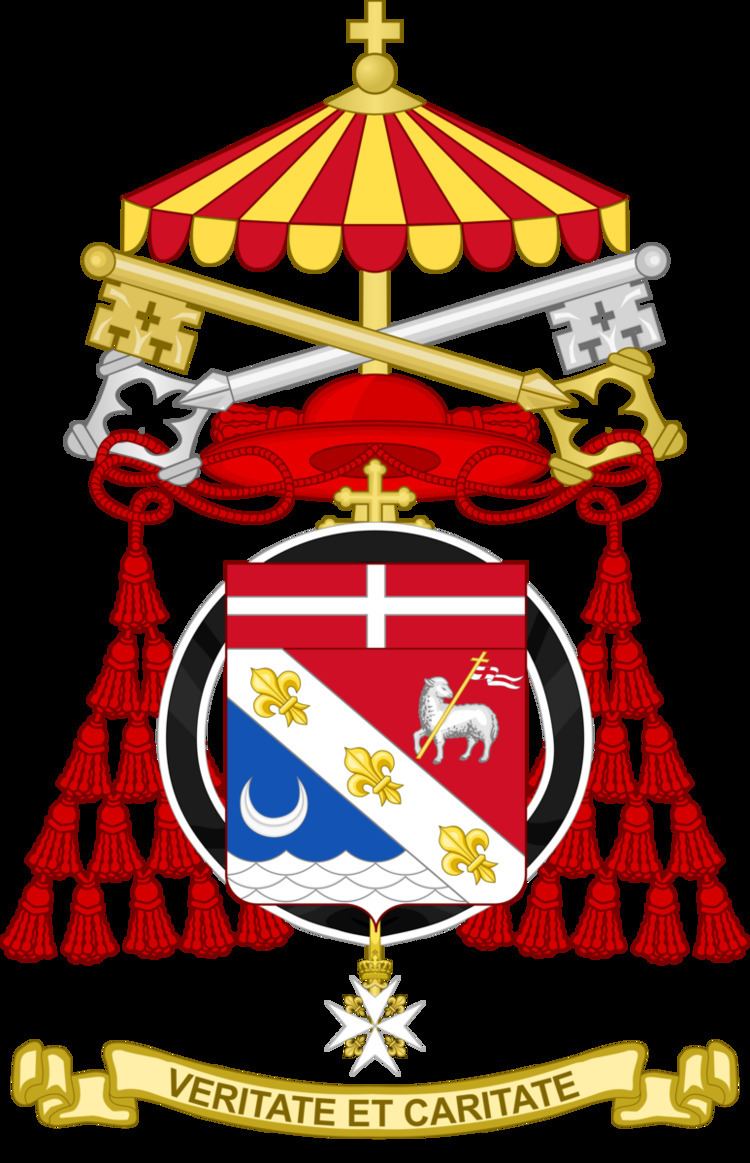 | ||
The Camerlengo of the Holy Roman Church is an office of the Papal household that administrates the property and revenues of the Holy See. Formerly, his responsibilities included the fiscal administration of the Patrimony of St. Peter. As regulated in the Apostolic Constitution Pastor Bonus (1988), the Camerlengo is always a Cardinal, though this was not the case prior to the 15th century. His heraldic arms are ornamented with two keys – one gold, one silver – in saltire surmounted by an ombrellino, a canopy or umbrella of alternating red and yellow stripes. These are also the arms of the Holy See during a Papal interregnum.
Contents
History
Until the 11th century, the Archdeacon of the Roman Church was responsible for the administration of the property of the Church (i.e., the Diocese of Rome), but its numerous ancient privileges and rights had come to make it a frequent hindrance to independent action on the part of the Pope; as a result, when the last Archdeacon Hildebrand was elected to the papacy as Gregory VII in 1073, he suppressed the Archdiaconate and the prelate entrusted with the supervision of the Apostolic Camera (Camera Apostolica), i.e., the possessions of the Holy See, became known as the Camerarius ("Chamberlain").
Prior to the 18th century, the Camerlengo enjoyed an income of 10,000 to 12,000 scudi a year out of the Apostolic Camera. He had jurisdiction over all suits involving the Apostolic Camera, and could judge separately or in association with the Clerics of the Apostolic Camera; he was not impeded by Consistory. He has appellate jurisdiction over suits decided by the Masters of the Roads. In a narration of the 18th century, the Camerlengo is the chief officer in the Apostolic Camera, the Financial Council of the Pope. In his office are the Governor of Rome (who is Vice-Chancellor), The Treasurer, the Auditor, the President, the Advocate General, the Fiscal Procurator, the Commissary, and twelve Clerks of the Chamber (one with the special title of Prefect of the Grain Supply, another Prefect of Provisions, another Prefect of Prisons, and another Prefect of Roads). Each Clerk of the Chamber received around 8,000 scudi a year, representing 10% of the business that passes through his office.
The powers and functions of the Camerlengo were diminished considerably in the 19th century, first by the reorganisation of the Papal government after the election of Pope Pius VII (30 October 1800); then by the reorganization of the Papal government after the return of Pope Pius IX from exile in 1850; and then by the loss of the Papal States in 1860 and the City of Rome in 1870. The chief beneficiary of these changes was the Cardinal Secretary of State. In the last century, the offices of Secretary of State and Camerlengo were held concurrently by Pietro Gasparri (from 1916–1930), Eugenio Pacelli (from 1935–1939), Jean-Marie Villot (from 1970–1979), and by Tarcisio Bertone (from 2007 until 2013).
On 20 December 2014, Pope Francis appointed Cardinal Jean-Louis Tauran as Camerlengo, succeeding Cardinal Bertone.
Responsibilities
The Camerlengo is responsible for the formal determination of the death of the reigning Pope; the traditional procedure–abandoned centuries ago–was to call his baptismal name (e.g. "Albine, dormisne?", meaning "[name], are you sleeping?"). After the Pope is declared dead, the Camerlengo takes possession of the Ring of the Fisherman and cuts it with shears in the presence of the Cardinals. This act symbolizes the end of the late Pope's authority and prevents its use in forging documents. The Camerlengo then notifies the appropriate officers of the Roman Curia and the Dean of the College of Cardinals. He then participates in the preparations for the conclave and the Pope's funeral.
Until a successor Pope can be elected, the Camerlengo serves as Vatican City's acting head of state. He is no longer, however, responsible for the government of the Catholic Church when the papacy is vacant sede vacante; that task was placed in the hands of the College of Cardinals by Universi Dominici gregis (1996). His power is extremely limited, being merely enough to allow Church institutions to continue to operate and perform some basic functions without making any definitive decisions or appointments that are normally reserved to other powers delegated by the Pope. Unlike the rest of Roman Curia, the Camerlengo retains his office during the sede vacante and functions as the executive director of the Vatican's operations, answerable to the College of Cardinals. This is primarily to carry out the College's decisions with regard to the funeral of the late Pope and the events leading up to the conclave. The only other people who keep their offices during this time are the Major Penitentiary, the Archpriest of St. Peter's Basilica, and the Vicars General for Rome and the Vatican City State.
List of Camerlengos
Those who have held the office of Camerlengo are:
Two Camerlengos have been elected Pope: Gioacchino Pecci (Pope Leo XIII) in 1878 and Eugenio Pacelli (Pope Pius XII) in 1939. Two others, Cencio Savelli (elected Pope Honorius III in 1216) and Rinaldo Conti di Segni (elected Pope Alexander IV in 1254) were not Camerlengo at the time of their election to the papacy, Cencio having served from 1188 until 1198 and Rinaldo from 1227 until 1231.
In popular culture
Dan Brown's novel Angels & Demons and its film adaptation featured a Camerlengo as a principal character.
